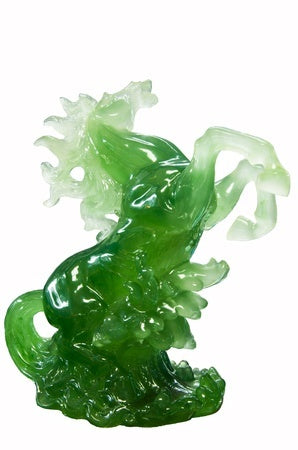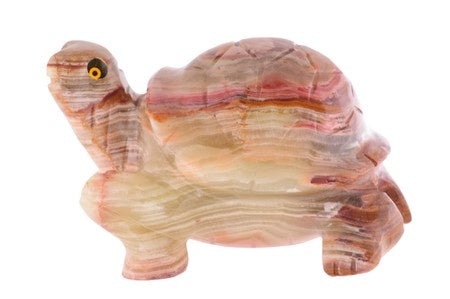Jade Gemstones - Two Gemstones for Two Empires
 To tell the story of jade is really to tell the tale of two ancient empires: the Chinese and the Mayans. Both cultures prized jade's beauty above all other gems and precious metals. Both the Mayans and the Chinese used carved jade beads to make jewelry and they also carved jade into tools and weapons. These two ancient empires prized not just the green stones that are popular today, but also black jade, purple jade and blue jade too.
To tell the story of jade is really to tell the tale of two ancient empires: the Chinese and the Mayans. Both cultures prized jade's beauty above all other gems and precious metals. Both the Mayans and the Chinese used carved jade beads to make jewelry and they also carved jade into tools and weapons. These two ancient empires prized not just the green stones that are popular today, but also black jade, purple jade and blue jade too.
Confucius once likened jade to virtue, and the gemstone took on important cultural significance in China. To express their fascination, the Chinese had a saying: “Gold has value, but jade is invaluable.”
The Chinese were not the only ones to feel this way. Jade was revered so highly by the Mayans and their Mesoamerican heirs that Aztec Emperor Montezuma once sent Cortez four jade beads in tribute. When the Conquistador dismissed the jade beads as nothing more than colored rocks, it’s said that Montezuma was greatly relieved to send gold instead!
Jadeite and Nephrite: Twin Stones The jade prized by the Mayans and Mesoamericans was actually a substance known as jadeite--formed in metamorphic rocks. Across the sea in China, valuable carved jade weapons, jewelry and ritual talismans were actually made of an entirely different substance: nephrite.
The jade prized by the Mayans and Mesoamericans was actually a substance known as jadeite--formed in metamorphic rocks. Across the sea in China, valuable carved jade weapons, jewelry and ritual talismans were actually made of an entirely different substance: nephrite.
While the Mesoamericans loved green jadeite, white “mutton fat jade” made of nephrite was the most valuable jade in China.
Mutton fat jade is also sometimes called “ancient jade” to distinguish it from the jadeite that has been imported into China in the course of the past two centuries. In actuality, both gemstones have ancient roots in different parts of the world and their use goes back to prehistoric times.
Both jadeite and nephrite come in a wide variety of colors, are extremely tough, and can be fashioned into carved jade weapons and implements that some say are stronger than steel. (Nephrite is actually harder to break than jadeite because of its chemical structure, but both stones hover near the same number on the Mohs scale of mineral hardness.)
Considering the similarities between nephrite and jadeite, it should be no surprise that when trade routes opened between the old world and the new, they were sold interchangeably as raw, polished or carved jade. Gemologists were unable to distinguish between the two varieties until the 19th century because they look so much alike and have very similar physical properties. (Perhaps it is no accident that these twin stones are associated with the astrological sign Gemini.)
Jadeite versus Nephrite Unfortunately, there are meaningful differences between jadeite and nephrite when it comes to jewelry or collecting antique carved jade.
Unfortunately, there are meaningful differences between jadeite and nephrite when it comes to jewelry or collecting antique carved jade.
Polished nephrite has a waxy finish whereas polished jadeite can shine like glass. As a general rule, paler stones are usually nephrite and the more brightly colored ones are jadeite. Most importantly, jadeite is rarer than nephrite and therefore, more expensive. (If you’re shopping for carved jade, jewelry or other keepsakes, most of what you’ll find is made of nephrite.)
East versus West
“Imperial Green” jadeite is said to be the most expensive gemstone in the world. A stone can command tens and even hundreds of thousands of dollars. Because the color has so much to do with the price, distinguishing between jade has given rise to a host of descriptive names. Dark green semi-translucent jadeite is called “Yunan Jade” whereas yellowish green jadeite is known as “Apple Jade” and white jadeite with green inclusions is called “Moss-in-Snow Jade.”
To Westerners, the most attractive, valuable and sought after types are the imperial green jade, spinach green jade, and apple jade. To Easterners, however, white mutton fat jade still holds the most magic. (Mutton fat jade can be clear, off-white or even yellow. At its best, mutton fat jade is also smooth and milky.)
Modern Jewelry
Imperial green jade and mutton fat jade are only the most well-known types. Because jade comes in a wide variety of colors and price ranges, it’s a popular choice for gemstone jewelry.
It can be dyed, so jewelry lovers can enjoy carved jade beads in a host of ornamental settings from necklaces to anklets to coordinate with every outfit. Blood red jade (also known as “Man Jade”) is very stylish. Pink and purple jade make for versatile and affordable choices in pendants, rings and bracelets. And black jade is an excellent alternative to onyx.
We no longer use carved jade to make weapons and farming implements, but the magical aura of jade still lingers. Like the Mayans and Chinese Empires before us, we cannot help but be enchanted by its beauty and glorious past.
Jade Links:
- International Colored Gemstone Association
- Jade Gemstones - Wikipedia
- Gemstone Gifts- Jade Gemstone Meanings

